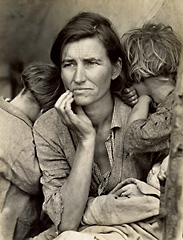Curriculum Materials: Art in America
|
|
Image 21 Dorothea Lange Questions: |
Migrant Mother
Lange photographed this 32-year-old mother and her children at a pea-pickers camp in Nipomo, California, at the end of a month of documenting migratory farm workers. Out of work, the family was living in a makeshift tent and eating frozen vegetables from the surrounding fields and wild birds caught by the children. Lange took a series of photographs of the family, each moving in closer to her subject. The last of the series was the closeup known as Migrant Mother. Reproduced in countless newspapers, books, magazines, and films, and shown in exhibitions worldwide, this compelling photo is an icon of the Depression.
The mother cradles a baby in her lap, while two young children cling to her sides, their faces turned from the camera. The woman, though facing Lange's camera, averts her eyes to gaze beyond it. Her gaunt, lined face, supported by her strong right arm and hand, reveals both her hardship and her inner strength.
The power of this photograph derives largely from
Lange's point of view and
COMPOSITION. By
moving in close for the shot and eliminating the setting,
she focused on the human element of her subject. She posed
the figures to create a triangle that enhances the sense of
a stable family, despite their economic situation. The
COMPOSITION is
tightly balanced to draw attention to the mother. The
shoulder of the child on the left, the mother's hand, and
the bent arm of the child on the right create an
IMPLIED LINE that
visually divides the photo in half. The arrangement of forms
implies a second line running from top to bottom, which
crosses the first line in the center.
|
|
